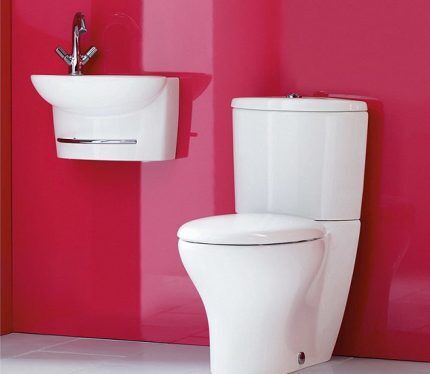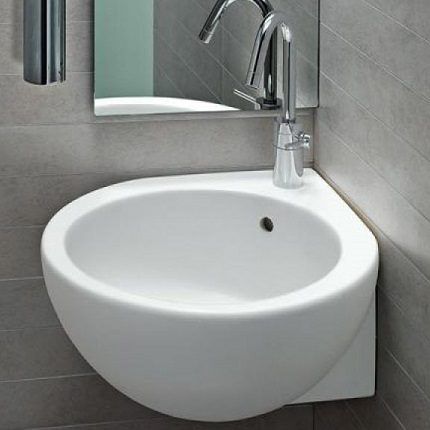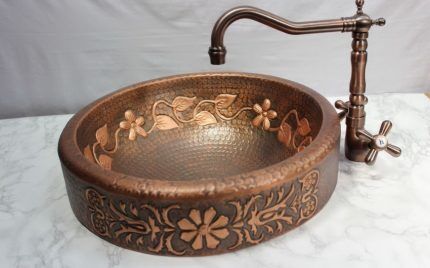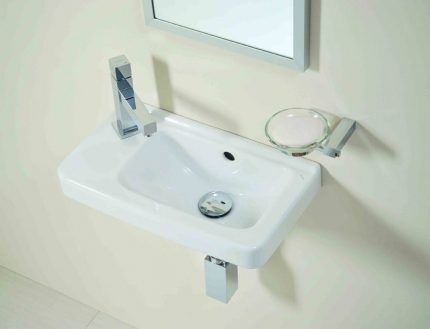Small sinks for the toilet: varieties, photo selection of options and features of choice
The basic requirements for plumbing for a small restroom are compactness, ergonomics, and suitable style.These parameters characterize a small toilet sink. It is a mini-copy of a standard device and is not inferior to it in terms of the number of design solutions.
You want your sink to be not only pretty, but also easy to use, right? Can't decide on a model? This is not surprising - the existing assortment is amazing, but at the same time makes it difficult to choose.
We will try to bring some clarity to this issue - in the article we will figure out how to choose such a washstand. We will help you understand the models and stylistic nuances well. The article’s material is also supplemented with colorful photo selections and video recommendations on the selection and installation of compact plumbing fixtures.
The content of the article:
General information and features of mini-sinks
Compact products are more often used as washstands. But they can also serve as a full-fledged washing bowl. If the bathroom is separate, it is convenient to equip an additional place in the toilet (even if it is miniature) for hygiene procedures.
Installing a mini-sink has its advantages:
- saving space;
- simple installation;
- ability to hide communications.
Such products also have disadvantages. The small size makes washing not very convenient; a lot of splashes form around.
Common sizes and shapes
The shape and size of the washbasin are selected depending on the purpose of using the device and the area of the room.
According to the form, the following options are distinguished:
- rectangular;
- corner;
- round;
- oval;
- fantasy.
The first two groups are the most common of those listed. Corner small toilet sinks are popular due to their maximum space savings.
But when installing washbasins of this type, you need to leave enough space around for their convenient use. Conventional rectangular structures require an approach from only one side.
The diameter of washbasins rarely exceeds 0.5 m. In numbers it looks like this: width - 30-55 cm, depth - 20-55 cm.

The dimensions of the sinks allow you to create basic amenities even in the smallest bathroom, but you also need to take into account the features of the models.
The average width of wall-mounted structures is 23-25 cm, depth parameters are 15-25 cm. These washbasins are produced in the most compact sizes to reduce the overall weight.
Corner ones are attached to 2 walls, so they can be wider - 35-40 cm, and heavier. If there is a cabinet, tulip or other support under the sink, you don’t have to worry about weight.
Materials used in production
Most mini toilet sinks are made from sanitary ceramics. It is divided into two groups - sanitary ware and sanitary porcelain.
Sanitaryware is made from white clay and a certain amount of impurities. The surface is porous, so to protect it from moisture, dirt, and detergents, it is covered with a thick layer of glaze.
Sanitary porcelain consists of the same white clay, but feldspar and quartz are added to it. Minerals give finished structures strength, durability, and low porosity.

It is quite difficult to distinguish these two materials from each other “by eye”: they are made from the same raw materials and are covered with the same glaze (for sanitaryware it is simply thicker). The composition of the ceramics can be found in the washbasin passport or from a store consultant.
Products made from other materials already fall into the premium category due to their high cost. Natural stone sinks look expensive, but their porous surface requires additional impregnation. The durability of the product depends on the quality of the moisture-resistant composition.

Artificial stone has a number of advantages over natural stone. It is just as durable and shock-resistant, but can withstand constant exposure to moisture without additional impregnation. And production by casting allows you to give products the most unimaginable shapes and colors.
Another interesting material used in the production of mini washstands is tempered glass. Light, transparent or colored products are quite rare, which makes them an exclusive item in interior design.

There are also mini-sinks made of acrylic on sale.They are distinguished by their low weight, durability, and a wide range of colors.
Manufacturers produce metal washstands especially for certain interior styles (minimalism, hi-tech, Victorian, oriental).
Products made of brass, bronze, patina, nickel, silver, even gold are characterized by high quality and unique appearance.

There are also relatively budget models made of stainless steel. But this strong and durable material is easily susceptible to mechanical stress; over time, scratches appear on the surface of the sink.
Wood is used as an unexpected material for plumbing. Products made from oak and larch become stronger from prolonged contact with water. Iroko and teak wood are considered water resistant.
The bowls of such washbasins are treated with oils, varnishes, and impregnations, but this does not eliminate their sensitivity to damage.
Types of washbasins according to installation method
If a major renovation of the toilet room is planned with the replacement of water pipes and wall decoration, the configuration of the model is not critical. When it is planned to update only the plumbing, this point becomes the main one, because the choice of washbasin directly depends on the design of communication systems.
The most popular hanging models
Such a washbasin is mounted on the wall using special pins. It is important to pre-mark the location of their installation. The studs are located on the same horizontal line, and the distance between them should clearly correspond to the segment between the holes on the sink.
When the markings are made, the washbasin is assembled (a siphon and mixer are attached), holes are drilled in the wall, fasteners are installed in them, on which the bowl is placed, and the structure is strengthened with nuts.
A silicone cushion must be laid between the sink and the wall. It serves as an additional fastening and softening buffer.
If the sink is heavy, it comes with additional fasteners. Let's look at possible design options for a restroom with miniature washbasins.
Wall-hung sinks take up little space, are easy to clean, and do not burden the interior. Some buyers are confused by the openness of water pipes, but thanks to stylish chrome siphons and neat modern designs, this problem is easily solved.
Floor-standing with a tulip or cabinet
Sinks with a tulip or cabinet are installed in the same way as wall-hung ones. The only difference is that their height is initially set by the lower structure and this makes the task somewhat easier.
If you choose a narrow “moidodyr” sink, it can be installed in the toilet without fastenings or glued to the wall with silicone.
Washbasins with legs are mounted close to the wall. They need to be protected from stress - the thin base may burst.
Please note that during installation, floor structures often require drainage into the sewer from below, but there are also examples with a discharge into the wall.
Built-in and overhead structures
In conditions of very limited space, it is better not to use such washbasins - they require a countertop. But here, too, mini-options are possible.
The principle of installing built-in products is similar to installing kitchen sinks. The washstand is glued to the base, which serves as a sealant and fastener.
Review of non-standard design solutions
One option to make the most of the space in a miniature restroom is to place the sink above the toilet.
A washstand above the cistern will not take up useful space and will help in arranging a tiny room.
Waves, waterfalls, drops - most design ideas are related to the water element. Shells with asymmetrical shapes stand out. They are convenient because they can be approached from different angles.
What to consider before purchasing?
Pay attention to the presence of an overflow hole in the model. Most manufacturers include it by default.
The overflow ensures the safety and ease of use of the sink.

When purchasing a mini-sink for your toilet, keep in mind that not only its cost and design features are important. The style and color of the washbasin should be in harmony with the overall design of the room.
Take preliminary measurements before purchasing. Imagine whether the chosen model will be convenient to use. The standard height of such structures is 75-95 cm. If there is a cabinet under the bowl, some adjustment to the height is needed.
A few more recommendations:
- If the bathroom is rectangular in shape, a corner model will be more convenient.
- When choosing a model with a cabinet, keep in mind that the cabinet material must withstand high humidity.
- It is better to choose a short and low mixer.
- If the kit includes a hygienic shower, all necessary components should be supplied with it.
The decision to purchase a washstand made of exotic material should be accompanied by an understanding of the complexity of care. Onyx, marble, granite will not last long if used improperly.If unpretentiousness and practicality are important, choose ceramics.
Already during the purchase process, inspect the product for chips, cracks, unevenly colored areas, stains and other defects.
Conclusions and useful video on the topic
An option for arranging a toilet room with a mini-sink in a “Stalin” style.
Mini washbasin and two glass shelves above it.
The idea of placing a washbasin in the wall.
The assortment of mini-sinks for the restroom surprises even overly picky buyers. Hundreds of colors, models, and sizes make it possible to find your own stylistic solution.
Measure the room, take into account the interior features, select the type of device to suit the existing conditions, think about the installation. After such preparation, it will be easier to make a decision at the time of purchase.




The very idea of such a sink is interesting and useful. And splashes are not a problem, because in modern mixers the stream is mixed with air through aerators and it does not splash at all.